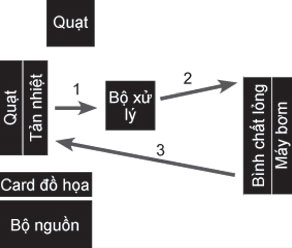Liquid heat sink
Liquid cooling system (liquid cooling system) is one of the top options with 'hands on' players who love technology or hardware overclocking. The advantage of liquid heat dissipation is the ability to transfer heat quickly, keeping hardware components at low temperatures.
 Computer hardware is often 'power- hungry ' and heat is directly proportional to the speed of operation. To avoid overheating, resulting in unstable operation, the hardware usually comes with a heat sink. Often, a fan with a normal fan (air cooler) or a standard heat sink with hardware still works effectively in most cases. However, if overclocked, to keep the hardware at low temperatures, you need to be equipped with better, more efficient heat sinks such as heat sinks using a combination of heat pipes (heatpipe) and cooling fans. Traditional or best is the liquid radiator. The liquid radiator (LCS for short) is quite expensive and is not easy to install, but if you really focus on keeping the system cool and quiet when operating, this solution is worth considering.
Computer hardware is often 'power- hungry ' and heat is directly proportional to the speed of operation. To avoid overheating, resulting in unstable operation, the hardware usually comes with a heat sink. Often, a fan with a normal fan (air cooler) or a standard heat sink with hardware still works effectively in most cases. However, if overclocked, to keep the hardware at low temperatures, you need to be equipped with better, more efficient heat sinks such as heat sinks using a combination of heat pipes (heatpipe) and cooling fans. Traditional or best is the liquid radiator. The liquid radiator (LCS for short) is quite expensive and is not easy to install, but if you really focus on keeping the system cool and quiet when operating, this solution is worth considering.
Structure and principles of operation
Basically, LCS is made up of components including Cooling block, heat treatment unit with attached cooling fan (Radiator), Liquid reservoir (Reservoir), pump (Pumb). . Included accessories are piping (Tubing) and coolant with water-based components and chemicals to increase the liquid conductivity. The operating principle of LCS is quite simple: the base absorbs heat from the processor and transfers it to the cooling liquid. The pump will push the liquid with this amount of heat to the heat treatment unit to cool it before repeating the new cycle.
For convenience, the article will show how to install the LCS XSPC Rasa 450 (RS120) for Intel Core i7-990X Extreme Edition processor inside Cooler Master 690. The Rasa 450 (RS120) has 3 main parts. Heat absorption base, heat treatment unit with 120mm cooling fan and pump integrated liquid tank. This radiator is compatible with AMD socket AM2 / AM2 + / AM3 processor, Intel socket 775/1156 / 1155LGA processor. In Vietnam, the Rasa 450 (RS120) costs about 3.9 million.
Note
The size and design of the chassis will affect the selection of other components as well as their installation locations. LCS is only suitable for mid-tower standstill or it is best for full-sized standstill if you want to build a liquid cooling system for both graphics cards, RAM and BMC chipset. The Cooler Master 690 case used in the article with the inside space is wide and airy to 'fit' the LCS components neatly.
Before doing so, outline the installation diagram and location of LCS components. To avoid warming up when you have to 'go all the way' inside the case before reaching the heat-absorbing base, you should choose the installation as shown above. The liquid comes out of the lowest temperature heat treatment unit, helping the processor to dissipate heat more efficiently.

installation
Turn off the device, remove the power cable of BMC and all hardware devices.
Remove the heat sink from the processor to install the heat sink base. You should clean the old thermal paste on the processor surface and apply a new layer of glue (with LCS).
Remove the cooling fan on the back of the case to attach the Radiator.
With the pump integrated liquid tank, fix them in the 5¼ 'drive bay.
Next, you should try it before you cut the tube into appropriate sections to connect the three parts. Refer to the documentation to determine the correct input and output of each part, making sure the tube is properly attached. Tighten the screw to prevent liquid leakage when the system is operating.
Pour the liquid into the container. Attach the power cable to LCS, directly activate the power supply by connecting the circuit between the blue and black pins of the ATX power line. The pump will push the liquid to the parts until the loop is completed. You need to continue filling the container with liquid until it is safe.
After installation is complete, do not start the computer but run it for about 24 hours to detect liquid leaks. This is the most important step to avoid future problems.
You should read it
- Decode the super exclusive cooling fan design from the world famous graphics card brands
- What is System Cooling Policy on Windows? How to set up?
- Should GPUs be liquid-cooled for better performance?
- AMD unveils Radeon RX 6900 XT liquid cooling version
- Top 10 best phone cooling fan models of 2023
- Computer cooling solutions on summer day
 Tips for using Galaxy Tab 10.1 (Part 1)
Tips for using Galaxy Tab 10.1 (Part 1) Tips for using Galaxy Tab 10.1 (Part 2)
Tips for using Galaxy Tab 10.1 (Part 2) Which USB format is reasonable?
Which USB format is reasonable? Fix USB error not for format
Fix USB error not for format Optimize the PC system to play games
Optimize the PC system to play games Compare speed of connection standards
Compare speed of connection standards